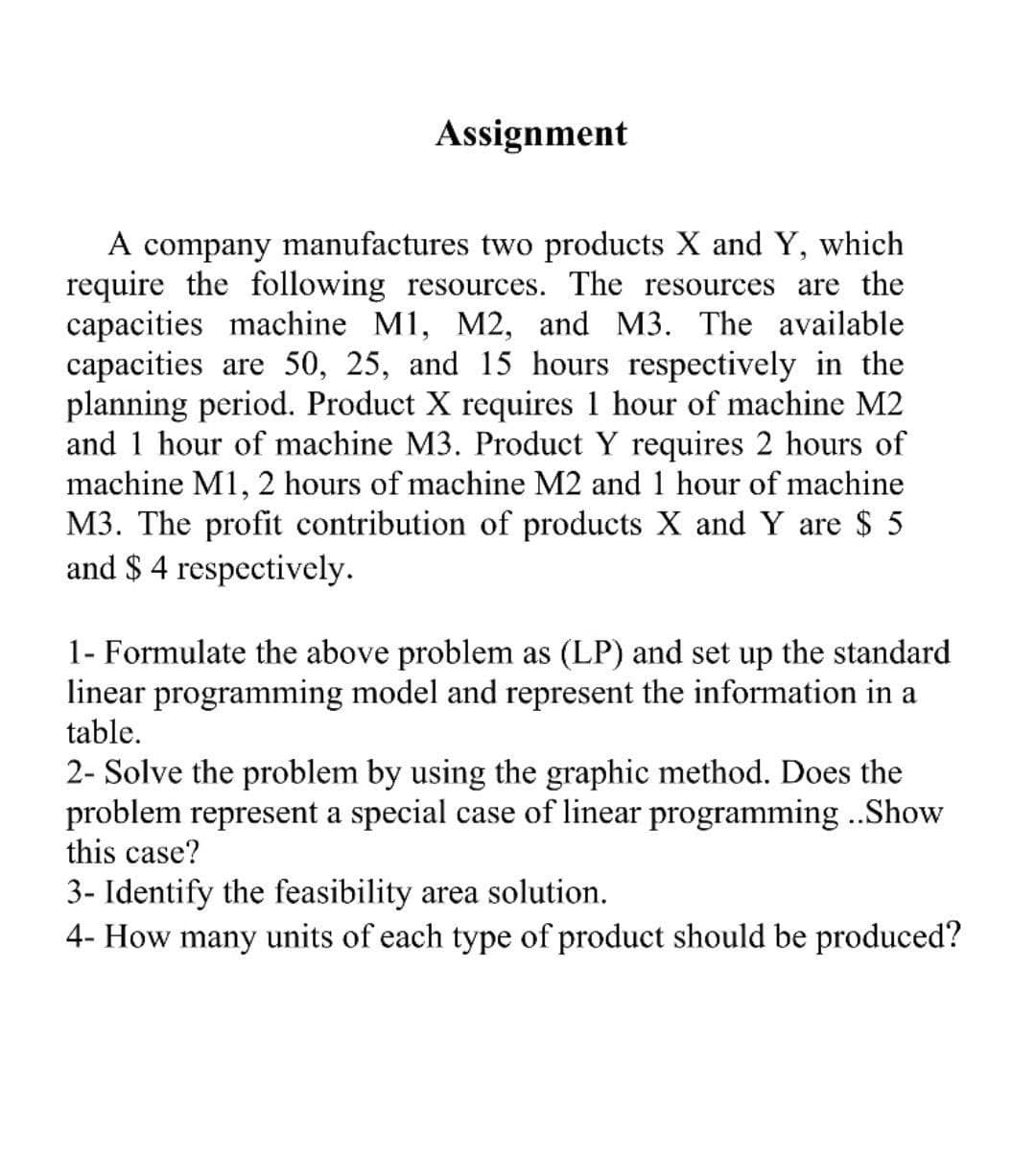A company manufactures two products X and Y, which require the following resources. The resources are the capacities machine M1, M2, and M3. The available capacities are 50, 25, and 15 hours respectively in the planning period. Product X requires 1 hour of machine M2 and 1 hour of machine M3. Product Y requires 2 hours of machine M1, 2 hours of machine M2 and 1 hour of machine M3. The profit contribution of products X and Y are $ 5 and $4 respectively. 1- Formulate the above problem as (LP) and set up the standard linear programming model and represent the information in a table. 2- Solve the problem by using the graphic method. Does the problem represent a special case of linear programming ..Show this case? 3- Identify the feasibility area solution. 4- How many units of each type of product should be produced?
A company manufactures two products X and Y, which require the following resources. The resources are the capacities machine M1, M2, and M3. The available capacities are 50, 25, and 15 hours respectively in the planning period. Product X requires 1 hour of machine M2 and 1 hour of machine M3. Product Y requires 2 hours of machine M1, 2 hours of machine M2 and 1 hour of machine M3. The profit contribution of products X and Y are $ 5 and $4 respectively. 1- Formulate the above problem as (LP) and set up the standard linear programming model and represent the information in a table. 2- Solve the problem by using the graphic method. Does the problem represent a special case of linear programming ..Show this case? 3- Identify the feasibility area solution. 4- How many units of each type of product should be produced?
Elements Of Electromagnetics
7th Edition
ISBN:9780190698614
Author:Sadiku, Matthew N. O.
Publisher:Sadiku, Matthew N. O.
ChapterMA: Math Assessment
Section: Chapter Questions
Problem 1.1MA
Related questions
Question

Transcribed Image Text:Assignment
A company manufactures two products X and Y, which
require the following resources. The resources are the
capacities machine M1, M2, and M3. The available
capacities are 50, 25, and 15 hours respectively in the
planning period. Product X requires 1 hour of machine M2
and 1 hor
of machine M3. Product Y requires 2 hours of
machine M1, 2 hours of machine M2 and 1 hour of machine
M3. The profit contribution of products X and Y are $ 5
and $ 4 respectively.
1- Formulate the above problem as (LP) and set up the standard
linear programming model and represent the information in a
table.
2- Solve the problem by using the graphic method. Does the
problem represent a special case of linear programming ..Show
this case?
3- Identify the feasibility area solution.
4- How many units of each type of product should be produced?
Expert Solution
This question has been solved!
Explore an expertly crafted, step-by-step solution for a thorough understanding of key concepts.
Step by step
Solved in 2 steps with 2 images

Knowledge Booster
Learn more about
Need a deep-dive on the concept behind this application? Look no further. Learn more about this topic, mechanical-engineering and related others by exploring similar questions and additional content below.Recommended textbooks for you

Elements Of Electromagnetics
Mechanical Engineering
ISBN:
9780190698614
Author:
Sadiku, Matthew N. O.
Publisher:
Oxford University Press

Mechanics of Materials (10th Edition)
Mechanical Engineering
ISBN:
9780134319650
Author:
Russell C. Hibbeler
Publisher:
PEARSON

Thermodynamics: An Engineering Approach
Mechanical Engineering
ISBN:
9781259822674
Author:
Yunus A. Cengel Dr., Michael A. Boles
Publisher:
McGraw-Hill Education

Elements Of Electromagnetics
Mechanical Engineering
ISBN:
9780190698614
Author:
Sadiku, Matthew N. O.
Publisher:
Oxford University Press

Mechanics of Materials (10th Edition)
Mechanical Engineering
ISBN:
9780134319650
Author:
Russell C. Hibbeler
Publisher:
PEARSON

Thermodynamics: An Engineering Approach
Mechanical Engineering
ISBN:
9781259822674
Author:
Yunus A. Cengel Dr., Michael A. Boles
Publisher:
McGraw-Hill Education

Control Systems Engineering
Mechanical Engineering
ISBN:
9781118170519
Author:
Norman S. Nise
Publisher:
WILEY

Mechanics of Materials (MindTap Course List)
Mechanical Engineering
ISBN:
9781337093347
Author:
Barry J. Goodno, James M. Gere
Publisher:
Cengage Learning

Engineering Mechanics: Statics
Mechanical Engineering
ISBN:
9781118807330
Author:
James L. Meriam, L. G. Kraige, J. N. Bolton
Publisher:
WILEY